Crawl Space Support and Foundation Repair

Have you noticed your home floors sagging or even dipping in some places? While sagging or downward sliding floors are a common problem in older homes, you need to know when to be concerned. Old homes tend to settle over time, so a little sagging is no big deal, but at times, sagging or dipping floors can be telltale signs of deep structural damage to your property, and you might need to look into foundation repair.
What is Crawl Space, and Why is it an Important Part of your Foundation?
Around 27 million houses in the United States are built on foundations that have a crawl space. The crawl space is a fundamental part of your house and can prove to be quite a reasonable space. Crawl spaces can be used for multiple explanations, such as subsurface plumbing, electrical wiring, and HVAC system installation, and can even be used for storage. They are particularly important in places that are more prone to flooding and help lessen food damage by providing a space between the foundation and your house. However, structural problems can cause the crawl space to sink or sag, which, therefore, can affect your house floors.
Why are your Floors Sagging?
It's quite common for the joints that support your home base to loosen and weaken over time. When this occurs, you will need to talk to a professional structural engineer who will likely assess your structure and foundation for the extent of damage and suggest foundation repair by repairing and reinforcing the joint and putting the leveling beams back in their place. However, this process can prove to be extremely difficult with houses that are built over crawl spaces.
There are a number of reasons for your house floors to sag, while some reasons might be purely superficial and have no consequences in the long run. Other reasons can indicate serious structural issues. Some of the common reasons for floors to sag are as follows:
1. Issues in your house foundation
Issues or damage in your house foundation are amongst one of the most common reasons for your house floors sagging. Suppose you notice any telling signs of foundation damage other than sagging floors, such as bowing walls, cracks in your house exterior, or doors and windows moving away from their frames. Make sure to call in a professional for an assessment right away.
2. House is aging
Houses, specifically those that have been built for several years, tend to settle over time, and finally, the house floors might even droop or dip down. But you never know when it can turn out to be something more profound than that. So, it is always better to have a professional such as a structural engineer come in and have a look around your property and assess the extent of damage.
3. Structural issues
Structural issues in your house foundation can be a serious issue and can cause the floors of your house to sag. Suppose the professional or builder who helps to make your house uses improper or sub-quality materials to build your house. In that case, they do not properly let the foundation settle and immediately start building. Overlooking important details like these proves to have some serious complications in the long run and causes your house to settle.
4. Water damage
Water in our basement flooding can be another reason for your floors to give way or sag. It again indicates issues in your foundation or more common plumbing problems. Water damage is a serious issue and cannot be considered not a serious one as it can generate additional damage to your property and also erode the woodwork or paint in your house.
5. Over Use
Like most things, overusing, wear and tear can also have a huge impact on your house. Even though it might not be noticeable at first, in the long run, overuse, such as installing heavy gym appliances or heavy furniture, especially in the upper portion of your house, can have an impact on your floors. So it's better to distribute the weight in your house accordingly and also keep rotating heavy objects around the house.
Leveling your floors for Crawl Space
All homes with old construction tend to have sagging floors regardless of their construction on either a solid basement or if they are built over a crawl space. The only difference is that houses built over crawl spaces don't have a solid foundation that can be used for giving support to your floors and putting in leveling beams. If you happen to contact a professional for foundation repair, they will likely introduce new supports in your floors, which the following steps can accomplish:
- Reinforcing the base by pouring concrete to strengthen the support
- Use hydraulic jacks to raise and level your house base
- Replacing or repairing your house joints
- Installing new leveling beams to support your house floor joints
Since this process involves heavy lifting and technical expertise, you are better off leaving off the foundation repair for the professionals and not risk DIY, as this can prove to be a serious hazard to you and others around you.
Conclusion
If you doubt that your floors are evolving unevenly or starting to settle, don't hesitate to call in a professional to have a look. Ignoring the signs and letting the foundation issue worsen is perhaps the most damaging thing you can do to your house. Even if your house has a crawlspace a structural engineer will evaluate your floor structure and suggest a solution that will suit your property and house needs.